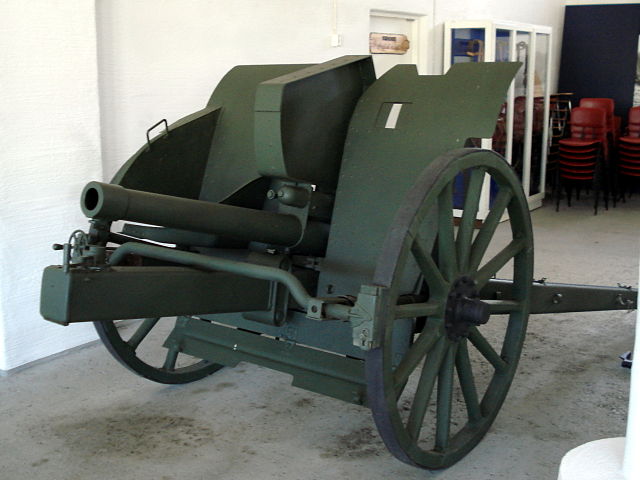
Italian Field Artillery
Although its Turin Arsenal manufactured a limited number of
mountain guns, before World War I, Italy acquired its artillery from foreign
sources, including Krupp of Germany, the Austro – Hungarian Skoda factory, and
the French Deport firm. These included the Krupp-designed 75mm 75/27 Mo. 06,
which also saw service in World War II, and the 75mm Gun Mo. 11 Deport.
Designed by the prolific Colonel Albert Deport of France and adopted in 1912,
the 75mm Gun Mo. 11 Deport introduced a dual recoil system as well as the split
trail carriage. The latter innovation incorporated twin hinged trails that
could be closed for limbering and then spread apart to stabilize the piece and
allow greater recoil at higher elevation. The Mo. 11 was acquired by other
powers as well as Italy, and the split trail carriage quickly became the standard
for nearly all field pieces worldwide.
Italy also fielded the 75mm Gun Mo. 06/12 and a howitzer
designated the Obice da 100/17 Mo. 14. An Austro-Hungarian design, the quick – firing
caliber 100mm Mo. 14 howitzer was adopted in 1914, and numbers were also
captured from the Central Powers at the end of World War I. The 100/17 saw
extensive Italian service during World War II and was also used by Polish and
Romanian forces.
Cannone da75/27 modello 11
Although the Cannone da75/27 modello 11 was designed by a
Frenchman it was produced only in Italy and may thus qualify as an Italian
weapon. The designer was named Deport, who conceived the idea of a recoil
mechanism that could stay fixed in a horizontal plane while the barrel could be
elevated to any angle desired. The advantages of this system are rather
obscure, but the Italian army certainly took to the idea to the extent that
they produced the modello 11 in large numbers.
The modello 11 was a relatively small field piece, as a
result mainly of the fact that it was originally ordered for cavalry use, In
time it was issued to other arms and became a standard field gun, Apart from
the unusual (an uncopied) recoil system, the modello 11 also had one other
novel feature for its day. This was split trail legs which gave the gun an unusually
wide traverse by contemporary standards, and also enabled the barrel to be elevated
to a maximum of 65* allowing the gun to be used in mountainous areas if
required, In action the trails were spread and instead of the more usual tail
spade the legs were held in place by stakes hammered through slots at the end
of each. This certainly held the gun steady for firing, but there were two disadvantages
to this system. One was that any large change of traverse could not be made
until the stakes had been laboriously removed from the ground; the other was
that on rocky or hard ground it took time to hammer in the stakes. For all
these potential troubles the Italians used the stake securing method on many of
their artillery designs, large and small.
The modello 11 was a handy little weapon with a good range;
its 10240-m (11200-yard) capability was well above that of many of its
contemporaries. However, for its size it was rather heavy, which was no doubt a
factor in its change from the cavalry to the field artillery, In action it had
a crew of at least four men although a full detachment was six, the extra two
looking after the horses.
It is known that some of these guns were used by the Italian
maritime artillery militia within the Italian coastal defence organization. The
modello 11s appear to have been used as light mobile batteries that could be
used for close-in beach defences of likely landing spots. Many of the modello 11s
were still in use in this role after 1940, and many other modello 11s were in
service with the field arti1lery. In fact so many were still on hand in 1943
that many came under German control, with the designation 7.5-cm Feldkanone
244(i), for use by the German occupation forces in Italy. By that time many
modello 11s had been modified for powered traction by conversion of the old
wooden spoked wheels to new steel-spoked wheels and revised shields; these
modernized equipments used pneumatic tyres.
Specification
Cannone da 75/27
Calibre: 75 mm (2,95 in)
Length of barrel 2.132 m (83.93 in)
Weights: in action 1076 kq (2,372 1b);
Travelling: 1900 kg (4,189 lb)
Elevation: – 15* to +65*
Traverse: 52*
Muzzle velocity: 502 m (1,647 ft) per second
Maximum range: 10240 m ( 11,200 yards)
Shell weight: 6.35 kg (14 lb)